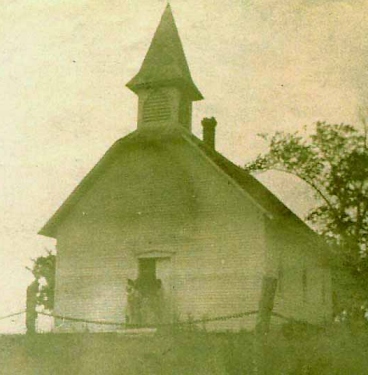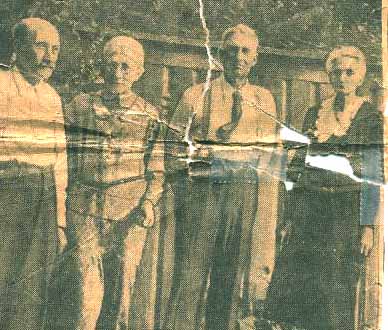 Waubonsie Methodist Church
The Waubonsie Methodist Church was the first religious organization in Mills County. That Methodism was the pioneer among the Protestant churches to organize their societies in Mills County
is evident by its history. The church of today is a continuation of that splendid beginning. It has had a continued existence for fifty-nine years. There was no Glenwood in that day, the little
village in that vicinity was known as Coonville.
Waubonsie Methodist Church
The Waubonsie Methodist Church was the first religious organization in Mills County. That Methodism was the pioneer among the Protestant churches to organize their societies in Mills County
is evident by its history. The church of today is a continuation of that splendid beginning. It has had a continued existence for fifty-nine years. There was no Glenwood in that day, the little
village in that vicinity was known as Coonville.
The Missionaries
The first Gentile preachers in Mills county were Cannon and Witten, missionaries of the Methodist Church of Missouri. Services were held in a log cabin at the head of a hollow about
half way between Glenwood and Hillsdale on the old Abe Thomas farm, now owned by Newton Reasoner. They delivered the first Protestant sermon given in the county. A two weeks meeting was held
in December, 1849, the probabilities are they organized a class, but nothing very definite relative to its history is known. Cannon took a claim where J.P. Kling now lives; he gave it to
James Folden, but he was too slow and another party jumped it.
Church History
The history of the Waubonsie church naturally divides itself into four periods as follows: Log cabin, log school house, old church and present church. The next period to consider is that
of the log school house days. In the latter part of 1850 a definite organization was effected under the leadership of William Simpson, a cousin of the famous Bishop Mathew Simpson.
Services were held about every two weeks in a log school house situated on what is now the Manford Linville farm. Those who attended services here well remember the large old fashioned fire place.
Among those who were regular attendants at the log cabin services were: J.L. and Nancy Burger, Abraham and Sarah Burger, Wilson and Adeline Bomar.
Mr. George Folden of the present membership is the only one now who holds a like relation in that early organization. Mr. Folden still has two books which he purchased of Mr. Simpson,
they were, "The Memory of Galilee" and "The Ohio Penitentiary". Mr. Folden also has a class book which dates back to 1851. The old church in 1854 was the first church building erected on the
present site. The land was given by W.M. Wolf, but the church was never dedicated. The lumber was sawed at the Wolfe mill. Part of the first church is now a portion of the residence of Mr. Eliza Wolf.
Rev. Isaac Kelly was the pastor. Prominent among its builders were W.M. Wolf, Greenbury Jones, J.S. Folden, Eli Withrow and Robert Withrow.
At one time smallpox broke out in the community and this building was used as a pest house.
The first funeral service in this building was held in April, 1857, and Arthur Boyd, the son of S. and N. Boyd was the first burial in the present cemetery. The last funeral in the old
church was Mrs. Hannah Kesterson, Oct. 13, 1886, by M.L. Wolf. The first funeral in the new church was Daisy Lambert, Dec. 13, 1886, by Robert Kesterson.
War Years
The men of the Waubonsie settlement responded nobly to our country's need during 1861-1865, and many of our church membership who offered their services are sleeping beneath the southern
sod while a few returned to find their last resting place among the scenes of their childhood.
Revivals
The Waubonsie church has experienced a number of stirring revivals, the last one was during the winter of 1884. It lasted eleven weeks and stirred the country for miles around,
resulting in several remarkable conversions.The present church was built in 1886 after the big revival of the fall of 1884. Amos Dean was the architect and builder. It was dedicated by
presiding elderW.T. Smith. Rev. Tillinghorse was pastor in 1905-06. Under Rev. Peter Jacobs pastorate the church was painted and other small improvements were made
involving a total expenditure of nearly $325.00
Waubonsie has had no small part in supplying material for the ministry.
- CHURCH MINISTERS:
- Baptist Church: John Newell
-
Christian Church: John Plumer
-
Methodist Church: Andy Folden, John Folden,
William Folden,
Henry Hubbard
-
Methodist Church: Joe Newell,
Eli Withrow,
Simpson Withrow,
Lafe Wolf
-
United Brethren Church:
S.S. Commonds,
James Hurst,
Robert Kesterson
The World-Herald's News Service, 1938
"Old Waubonsie Church is Saved for Community"
Tabor, Iowa - Historic Old Waubonsie church, five miles northwest of here, will be saved for the descendants of the Pioneers who built it. Assurance that these
traditions will not die came recently when A. J. Buckingham acquired the old building from the Methodist conference. Mrs. Buckingham and Mrs. Estes are daughters of "Uncle Billy" Wolf, who gave the land, and lumber,
for the first church. Mr. Buckingham acted for residents of the community. The church is on the site of one of the first camp meetings in southwest Iowa.
The original congregation was the first religious group in Mills county. At the time, the town of Glenwood was known as Coonsville. In 1849, religious meetings were
held in a log cabin on the Abe Thomas farm. In 1850, William Simpson, cousin of Bishop Matthew Simpson, conducted services every two weeks in a log house on the farm
now owned by the Manford Linville family.


Waubonsie People
Site for the church was given by W. M. Wolf, known as "Uncle Billy".
The first church was erected in 1854, but for some reason was never dedicated.
Lumber for the building was sawed at the Wolf sawmill. The first pastor was Rev. Isaac Kelly. The first funeral held in the church was that of "Uncle Billy".
Waubonsie Church
The present church was erected in 1886, near where the old church stood. The architect and builder was Amos Dean. The church closed for several years in the early 1970's. It was
re-stored and re-opened in 1975 through donations. When it re-opened it was named Waubonsie Bible Church.

Notes from Mills County Cemetery book, 1982
Waubonsie Cemetery is located about seven miles south of Glenwood on county road L45 or about six miles northwest of Tabor, in Lyons Township, NE 1/4 of Section 24.
William Wolfe gave an acre of land for Waubonsie Church site some of which may be the cemetery. The church and cemetery were named for Chief Waubonsie who lived
and was given a tree burial in the hills south of the church. Many burial sites are unmarked. The oldest stone is for Arthur, son of S & N Boyd who died 21 April 1857
at the age of ten years and ten months.
Some time ago a newspaper had interesting articles about Matilda (Hanks) Utterback Anthony who passed away in 1863.
She was a distant relative of Abraham Lincoln's mother. There is a small stone which marks her burial site.
The original church built in 1852 was destroyed
in 1864 after it had been used as a hospital during a smallpox epidemic in the county during the Civil War. It is believed there are a number of unmarked burials of
victims of this epidemic.
Source: Waubonsie Methodist Church, by M. L. Wolfe
The Illustrated Historical Atlas of Mills & Fremont Counties, 1910
(Submitted by Deb Smith)

